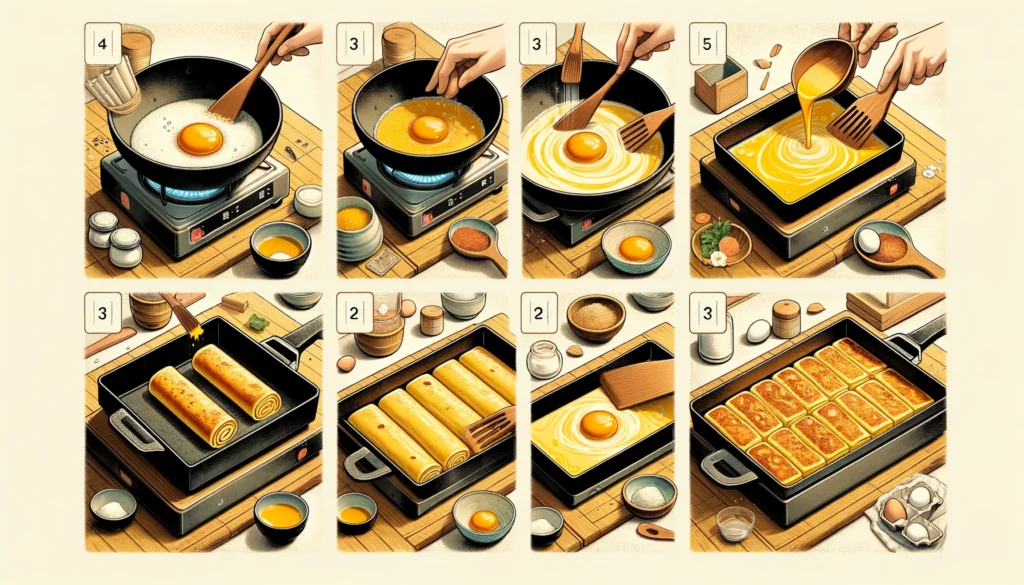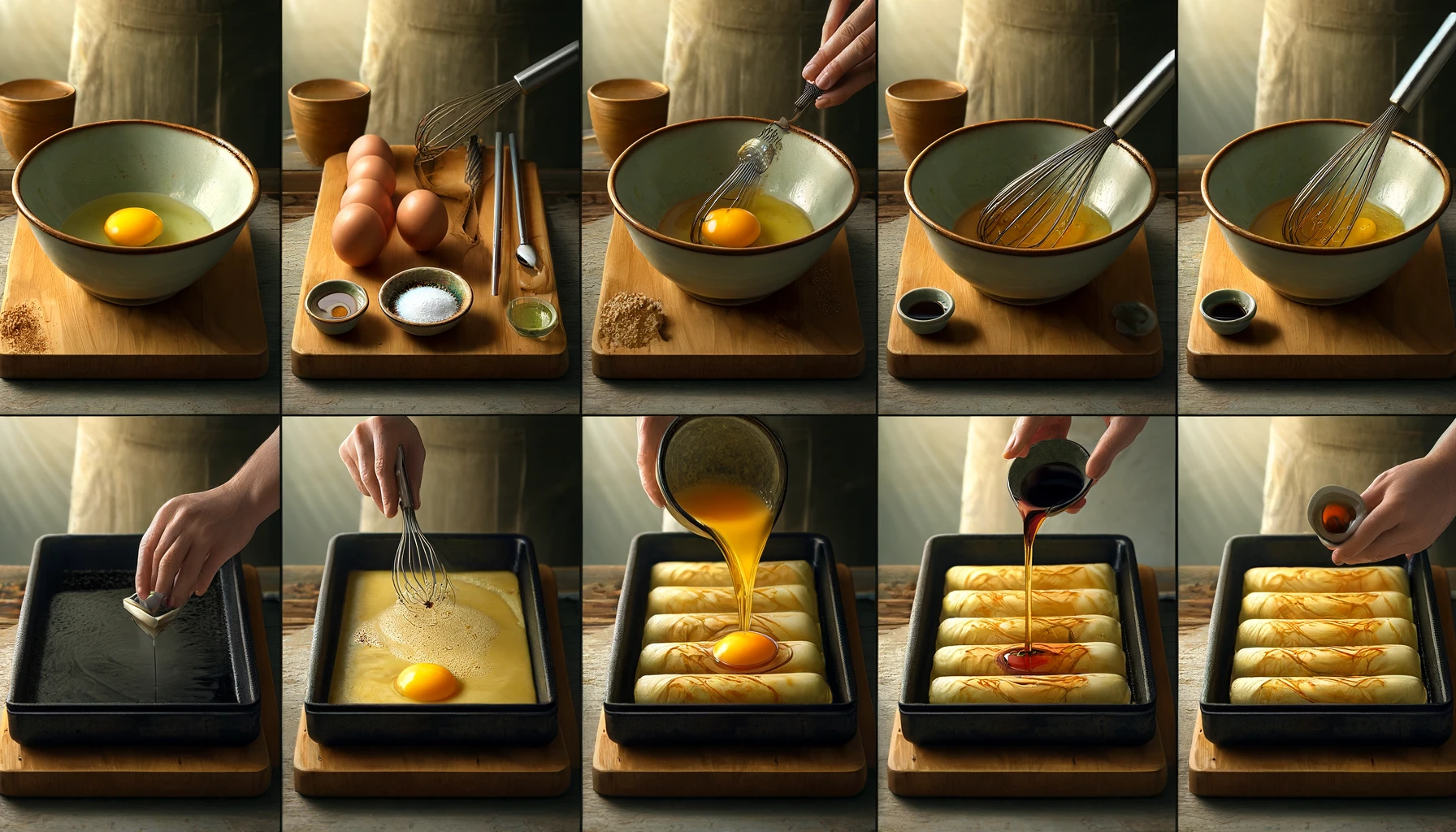Discover the artistry behind mastering the Japanese Tamagoyaki Recipe, a cherished tradition in Japanese cuisine. Tamagoyaki, a traditional Japanese dish, is a type of rolled omelette made by rolling together thin layers of seasoned egg in a rectangular pan. The dish is known for its sweet yet savory flavor and delicate texture. Tamagoyaki is a staple in Japanese cuisine, often served as a breakfast item, side dish, or used as a filling in sushi or bento boxes. Its popularity has spread worldwide, with many people enjoying its unique taste and beautiful presentation. This versatile dish can be enjoyed hot or cold, making it a favorite among those looking for a delicious and satisfying meal.
Evolution of the dish over time.
Tamagoyaki, a Japanese omelette, has a rich history dating back to the Edo period (1603-1868). Initially, it was a simple mixture of eggs cooked in a rectangular pan. The dish gained popularity due to its simplicity and versatility.
Over time, tamagoyaki evolved, with cooks adding various ingredients such as dashi (a type of Japanese stock), soy sauce, sugar, and mirin (a sweet rice wine). These additions enhanced the flavor and gave the omelette a slightly sweet taste.
Moreover, tamagoyaki also became associated with bento boxes, as it was a convenient and nutritious addition to these lunch boxes. Its compact size and ability to be eaten cold made it ideal for bento meals.
Today, tamagoyaki is a staple in Japanese cuisine, served in homes, restaurants, and even as street food. Its history reflects the adaptability and creativity of Japanese cooking, where a simple dish has evolved into a beloved culinary tradition.
Ingredients for Tamagoyaki
Tamagoyaki, a classic Japanese rolled omelette, requires a few key ingredients that are crucial for its unique texture and flavor. Here’s a list of ingredients and their importance in the dish:
- Eggs: The main ingredient, eggs provide the base for Tamagoyaki and give it its distinctive texture and taste. They also help in binding the layers together as the omelette is rolled.
- Sugar: Adds a hint of sweetness to balance the savory flavors. It also helps in giving the omelette a slightly caramelized exterior.
- Soy Sauce: Provides umami and savory flavors to the dish. It adds depth and richness to the overall taste of Tamagoyaki.
- Mirin: A sweet rice wine that adds sweetness and a subtle flavor to the omelette. It also helps in tenderizing the eggs.
- Salt: Enhances the overall flavor profile of the dish and balances the sweetness from the sugar and mirin.
- Dashi: A Japanese cooking stock made from fish and seaweed. It adds a savory, umami-rich flavor to the omelette.
- Oil: Used for cooking the omelette and preventing it from sticking to the pan. It also adds richness to the dish.
- Optional Ingredients: Some variations of Tamagoyaki may include additional ingredients such as chopped scallions, mushrooms, or fish flakes (katsuobushi) for added flavor and texture.
Creating the perfect Japanese Tamagoyaki requires attention to detail, as each ingredient plays a crucial role in the overall taste and texture of this delightful dish. The combination of eggs, soy sauce, mirin, and sugar results in a harmonious blend of sweet, savory, and umami flavors that make Japanese Tamagoyaki a beloved favorite in Japanese cuisine.

Tools Required for Making Tamagoyaki
Making tamagoyaki, a Japanese rolled omelette, requires a few specific tools, including a special rectangular pan called a makiyakinabe. This pan is essential for creating the signature shape and texture of tamagoyaki. Here’s a detailed look at the tools required:
Makiyakinabe (Tamagoyaki Pan):
This is a rectangular, flat-bottomed pan with slightly sloped sides. It is specifically designed for making tamagoyaki and is essential for achieving the layered, rolled shape of the omelette. The pan’s size can vary, but a standard size is around 7-8 inches long and 6-7 inches wide.
Bamboo Tamago Sushi Mat:
While not essential, a bamboo sushi mat can be useful for rolling the tamagoyaki. It helps to shape the omelette evenly and tightly, resulting in a neat roll.
Spatula or Tamagoyaki Turner:
A special tamagoyaki spatula or turner is often used for flipping and rolling the omelette. These spatulas are typically rectangular and thin, making it easier to handle and shape the omelette.
Whisk or Fork:
To beat the eggs thoroughly before cooking, you’ll need a whisk or fork. This helps to incorporate air into the eggs, resulting in a lighter texture.
Oil Brush or Paper Towel:
To grease the pan, you can use an oil brush or a folded paper towel. This helps to prevent the omelette from sticking and aids in the rolling process.
Heat Source:
A stovetop or hot plate is needed to cook the tamagoyaki. It’s important to adjust the heat carefully to prevent burning and ensure even cooking.
Plate or Cutting Board:
You’ll need a plate or cutting board to transfer and serve the tamagoyaki once it’s cooked.
Optional Ingredients:
Depending on your recipe, you may need additional ingredients such as eggs, dashi (Japanese soup stock), sugar, soy sauce, mirin (sweet rice wine), and fillings like nori (seaweed) strips, spinach, or cheese.
By using these tools and ingredients, you can create delicious and visually appealing tamagoyaki at home.
Preparing the Eggs for Tamagoyaki
To prepare the eggs for Tamagoyaki, follow these steps for a delicious and smooth-textured omelette:
Beat the Eggs:
Crack the eggs into a bowl and beat them until the yolks and whites are well combined. Use chopsticks or a fork to beat the eggs, avoiding incorporating too much air, which can create a fluffy texture rather than the desired smoothness.
Season the Eggs:
Add seasonings like soy sauce, sugar, and mirin to the beaten eggs. These ingredients not only add flavor but also contribute to the signature sweet and savory taste of Tamagoyaki. Use about 1 tablespoon of soy sauce, 1 teaspoon of sugar, and 1 teaspoon of mirin per 4 eggs, adjusting to taste.
Mix Thoroughly:
Mix the seasonings into the beaten eggs thoroughly to ensure even flavor distribution.
Strain the Mixture (Optional):
For an even smoother texture, strain the egg mixture through a fine sieve to remove any lumps or stringy bits.
Cooking Process:

When preparing the Japanese Tamagoyaki Recipe, it’s crucial to pour a thin layer of the egg mixture into the pan and gently roll it up while it’s still slightly runny. Repeat this process, gradually adding more egg mixture each time, until all the egg is utilized, resulting in the characteristic multiple layers of this beloved dish.
By following these steps, you can achieve a beautifully smooth and flavorful Tamagoyaki.
Cooking Technique for Tamagoyaki
Tamagoyaki, a Japanese rolled omelette, requires a special technique to achieve its signature shape and texture. Here’s how to make it:
Prepare the Egg Mixture:
Beat eggs in a bowl with soy sauce, mirin, and sugar for a sweet-savory flavor.
Heat the Pan:
Use a rectangular tamagoyaki pan or a small non-stick skillet. Begin by heating a pan over medium heat, then add a drizzle of oil.
Pour the Egg Mixture:
Pour a thin layer of egg into the pan, tilting to spread evenly. Cook until the bottom is set but the top is still slightly runny.
Roll the Omelette:
Using chopsticks or a spatula, gently roll the omelette from one end of the pan to the other.
Move to One Side:
Push the rolled omelette to one side of the pan.
Oil the Pan Again:
Add more oil to the empty side of the pan and pour another thin layer of egg. Lift the rolled omelette slightly to let the new egg mixture flow underneath.
Roll Again:
Once the new layer is partially set, roll it up again, incorporating the first roll.
Repeat:
Repeat the process, rolling and adding layers until all the egg mixture is used.
Shape the Omelette:
Press the rolled omelette into a rectangular shape using the edge of the pan.
Cool and Slice:
Let the tamagoyaki cool slightly, then slice into rounds or squares for serving.
Tips for Perfect Tamagoyaki:
- Use low to medium heat to avoid burning the eggs.
- Roll the omelette tightly to create defined layers.
- Add fillings like vegetables, shrimp, or nori for added flavor and texture.
- Use a bamboo sushi mat to help roll the omelette evenly.
Variations of Tamagoyaki
- Dashimaki Tamago: A type of tamagoyaki made with dashi stock for a savory umami flavor.
- Usuyaki Tamago: A thin omelette often used as a wrapper for sushi or served with broth.
Regional Variations and Unique Recipes
- In Kansai region, tamagoyaki is often sweeter and served as a dessert or snack.
- In Hiroshima, tamagoyaki is layered with noodles and vegetables in a savory pancake dish called Hiroshima okonomiyaki.
Tamagoyaki, a beloved Japanese dish, offers a delightful culinary canvas for experimentation. Whether relished solo, embellishing sushi, or nestled within a bento box, its versatility knows no bounds. Dive into the realm of culinary creativity, infusing diverse fillings and flavors to craft your personalized Japanese Tamagoyaki Recipe. With each delicate fold and precise cooking technique, you’ll create a savory masterpiece that captures the essence of this iconic Japanese delicacy.
Serving and Presentation
Traditional Ways to Serve Tamagoyaki: Tamagoyaki is often served as a standalone dish or as part of a Japanese breakfast or bento box. It can be enjoyed hot or cold, and is commonly accompanied by soy sauce, grated daikon radish, or grated ginger for dipping.
Looking to elevate your culinary game with a contemporary flair? Let’s delve into some inventive plating concepts that will breathe new life into your dishes. One such innovation involves the timeless Japanese Tamagoyaki Recipe. Instead of the traditional approach, envision cutting the Tamagoyaki into bite-sized portions and adorning them on skewers, crafting a delightful and sophisticated appetizer. To further tantalize the palate, consider rolling the Tamagoyaki with nori, infusing it with the essence of seaweed while enhancing its visual allure. Elevate the experience by garnishing with sesame seeds or bonito flakes, adding a gourmet touch that will leave your guests yearning for more. Embrace the fusion of tradition and modernity with these creative plating ideas, transforming a classic dish into a culinary masterpiece.
Health Benefits of Tamagoyaki
Nutritional Value of Tamagoyaki: Tamagoyaki is a good source of protein, vitamins, and minerals. It is low in carbohydrates and can be a nutritious addition to a balanced diet.
How It Fits into a Balanced Diet: Tamagoyaki can be part of a balanced diet when paired with other nutrient-rich foods. It provides essential amino acids necessary for muscle repair and growth. For more on healthy breakfast options, check out these delicious and nutritious egg muffins, perfect for a balanced diet.
FAQs about Japanese Tamagoyaki
When preparing a classic Japanese Tamagoyaki recipe, the number of eggs used is crucial to achieving the perfect balance of flavors and textures. Furthermore, typically, 3-4 eggs are employed in the process; however, this can be adjusted based on personal preference and the desired outcome. Additionally, the size of the eggs and the desired thickness of the omelet also play roles in determining the ideal quantity. So whether you’re crafting a traditional Tamagoyaki or adding your own twist to the recipe, ensuring the right number of eggs is key to a delightful culinary experience.
Can I Make Tamagoyaki Without a Special Pan?
While a rectangular tamagoyaki pan is ideal for making the traditional layered omelet, you can use a regular frying pan to make a simpler version by folding the omelet over itself as it cooks.
Is Tamagoyaki Suitable for Vegetarians?
Tamagoyaki can be vegetarian if made without added ingredients like shrimp or fish flakes. Using vegetable-based dashi stock instead of bonito flakes can also make it suitable for vegetarians.
What Is the Difference Between Tamagoyaki and Western Omelets?
Tamagoyaki is a sweet and savory rolled omelet, while Western omelets are typically folded and filled with ingredients like cheese, vegetables, and meats.
Can I Freeze Tamagoyaki for Later Consumption?
Yes, you can freeze tamagoyaki, including this Japanese Tamagoyaki Recipe. Let it cool completely, then wrap it tightly in plastic wrap before placing it in the freezer. To reheat, thaw it in the refrigerator overnight and gently reheat in a pan or microwave.
External Links:
Here are three external links with excellent step-by-step guides on making authentic Japanese Tamagoyaki:
- Chef JA Cooks provides a detailed guide on making traditional tamagoyaki, emphasizing techniques like straining the egg mixture to achieve a bouncy texture and tips on using the right pan. You can read more about their method and additional tips on their website.
- Japanese Taste offers an easy recipe that explores the cultural significance of tamagoyaki in Japanese cuisine. They include basic steps for preparing tamagoyaki, suitable for beginners, and discuss regional variations in flavor. Check out their recipe and cultural insights here.
- RecipeTin Japan focuses on dashimaki tamago, a variation of tamagoyaki that includes dashi for added flavor. Their guide includes detailed instructions on the rolling technique and how to achieve the perfect texture. Learn more about their approach here.
Each of these sources provides unique insights and tips, making them great resources for anyone looking to master the art of tamagoyaki.

